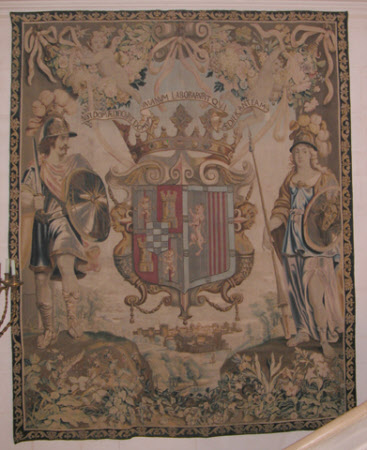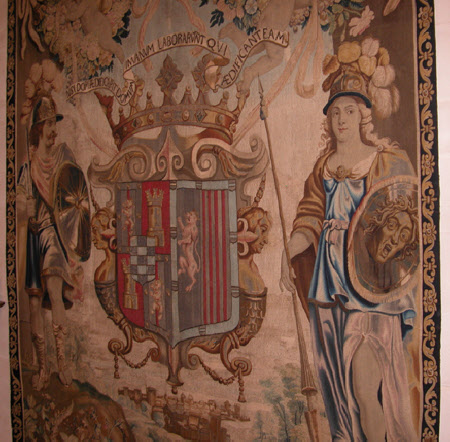Portière with the Arms of Don Luis de Benavides, Marqués de Caracena
Geraert van der Strecken (Brussels, fl. 1647 – d. 1677)
Category
Tapestries
Date
circa 1660
Materials
Tapestry, wool, silk and gilt metal wrapped thread, 8 warps per cm
Measurements
3450 x 2760 mm
Place of origin
Brussels
Order this imageCollection
Anglesey Abbey, Cambridgeshire
NT 516754
Summary
Tapestry, wool, silk and metal thread, 8 warps per cm, Portiere with the Arms of Don Luis de Benavides, Marqués de Caracena, Gerard van der Strecken, Brussels, c. 1660. An armorial tapestry with a central coat of arms flanked by two allegorical figures. On the left is Mars, carrying a shield and a sword and wearing a plumed helmet and short tunic, and on the right Minerva, holding a spear and shield bearing Medusa's head and wearing a long robe and a plumed helmet. The central shield is suspended by ribbons held by two putti who hover amid swags of fruit at the top of the tapestry. In the background is a landscape with a city on the horizon below the coat of arms.
Full description
The tapestry once formed part of an ensemble of thirty-nine tapestries commissioned by Don Luis de Benavides, Marqués de Caracena and woven in Brussels in c. 1660. The series was recorded in Benavides's posthumous inventory in 1668 and consisted of fourteen large figurative hangings with scenes from the 'Story of Scipio', four entrefenêtres (vertical panels designed to hang between windows), eight smaller tapestries to hang above windows, seven panels to hang above doors, and six armorial portières made to hang over doorways, including the piece now at Anglesey Abbey (Delmarcel 2010, pp. 96-105). All the tapestries were woven with large quantities of gilt metal thread. In all this was one of the most ambitious recorded tapestry commissions of the late seventeenth century. The fourteen 'Story of Scipio' hangings in Benavides's ensemble were based on one of the most celebrated tapestry series of the Renaissance, the 'Deeds and Triumphs of Scipio' designed by Giulio Romano and Gianfrancesco Penni in the 1520s. The original Scipio set comprised 22 pieces and was woven in Brussels for François I, King of France. The cartoons remained in Brussels and further sets were woven from the designs in the later sixteenth century. In the late seventeenth century the 'Scipio' series was woven again, this time by a consortium of Brussels entrepreneurs including Gerard van der Strecken (whose signature appears on the tapestry at Anglesey Abbey). The set made for Benavides dates from this period, and is unique in including additional overdoors, entrefenêtres and portières like the panel at Anglesey Abbey. Other important patrons who had 'Scipio' tapestries made in the late seventeenth century include the Duke of Parma, Duke Charles IV of Lorraine Vaudémont, and Charles Emmanuel III, Prince of Savoy. Examples survive in the Palazzo del Quirinale, Rome, the Palazzo Labia, Venice, the Kunsthistorisches Museum, Vienna and the Château de Tarascon, France (Forti-Grazzini 1994, vol. I, pp. 206-208; Delmarcel 2010, p. 97). Within the National Trust's collection, there is at Lyme Park a single tapestry of 'The Continence of Scipio' woven with metal thread that dates from this period, although its provenance is unknown (no. 500312). Benavides's set of 'Scipio' tapestries was split up at some point before 1907 and parts survive in the Collection Toms Pauli, Lausanne; Wawel Castle, Cracow; the Museo de Bellas Artes, Buenos Aires; Schloss Fasanarie, Eichenzell/Fulda and the Detroit Institute of Arts, Michigan; others have surfaced on the art market (Delmarcel 2010, pp. 98-99). The tapestry at Anglesey Abbey bears the mark of the city of Brussels and the initials 'GVDS' (altered by later restoration), the signature of the Brussels tapestry entrepreneur Gerard van der Strecken (d. 1677). Van der Strecken was first mentioned in 1644 as the partner of Jan van Leefdael. In 1647 he gained a privilege, and in 1657 he was one of the founder members of the Brussels Tapissierpand or tapestry market. His signature appears on a number of large figurative tapestry sets of the mid seventeenth century, and he often worked in partnership with other Brussels entrepreneurs including Jan van Leefdael, whose signature appears on other tapestries from Banavides's 'Scipio' set. Don Luis Francisco de Benavides Carrillo de Toledo, Marqués de Caracena and Marqués de Fromista (1608-1668) was a member of the upper Spanish nobility, and followed a career in the military. He took part in numerous campaigns in Flanders and Italy between 1629 and 1659, when he defeated Don Juan José of Austria at the Battle of the Dunes and replaced him as Governor of the Spanish Netherlands, a position he would hold until 1664. Two of the tapestries in the Scipio series bear the date 1660, and it seems probable that Benavides commissioned the set to celebrate his new position. Brussels, where the tapestries were woven, was the capital of the Spanish Netherlands which Benavides now governed. The arms on the tapestry at Anglesey Abbey are those of Don Luis de Benavides impaling those of Catalina Poncé de Leon (1597-1667) whom he married in 1652. The Benavides arms are quarterly 1 and 4, Or a Pallet Gules, with a Lion of the same over all, the lion charged with three bands argent in the guise of a ribbon that encircles his body three times, within a bordure Argent charged with eight Cauldrons Sable (Benavides); 2 and 3: Gules a Tower triple towered Or (Carrillo de Toledo); over all an inescutcheon chequy of Azur and Argent. The Poncé de Leon arms are per pale, Argent, a Lion Gules (Leon), and Or, four Pallets Gules (Aragon), within a bordure Azur, charged with eight shields with the arms of Vidaure which are Or a Fess Azur. The shield is surmounted by a the coronet of a Marquis and a bannarette with Benavides's motto, 'NISI DOM[INVS] AEDIFICA[VE]RIT DOMVM IN VANVM LABORARVNT QVI AEDIFICANT EAM', 'Except the Lord do build the House, the builders work in vain', from Psalm 127. (Helen Wyld, 2011)
Provenance
Commissioned by Don Luis de Benavides, Marqués de Caracena in c. 1659, and woven in Brussels, c. 1660; recorded in Benavides's posthumous inventory, 1668; subsequent history unknown, until acquired by Huttleston Rogers Broughton, 1st Lord Fairhaven (1896-1966); bequeathed by Lord Fairhaven to the National Trust with the house and the rest of the contents.
Credit line
Anglesey Abbey, The Fairhaven Collection (The National Trust)
Marks and inscriptions
Lower border, left: 'BB' mark of the City of Brussels Lower border, right: 'GVDS' mark of Gerard van der Strecken (modified by restoration) Bannerette above shield: NISI DOM. AEDIFICARIT DOMVM IN VANVM LABORARVNT QVI AEDIFICANT EAM
Makers and roles
Geraert van der Strecken (Brussels, fl. 1647 – d. 1677), workshop
References
Delmarcel, 2010: Guy Delmarcel, ‘The Flemish Tapestries’, in Guy Delmarcel, Nicole de Reyniès and Wendy Hefford, The Toms Collection Tapestries of the Sixteenth to Nineteenth Centuries, Zürich 2010, pp. 25-157 Delmarcel, 2007: Guy Delmarcel, ‘Tapestry in the Spanish Netherlands, 1625-60’, in Tom Campbell (ed.), Tapestry in the Baroque: Threads of Splendor, exh. cat. Metropolitan Museum of Art, New York 2007, pp. 203-217 Campbell, 2002: Thomas Campbell (ed.), Tapestry in the Renaissance: Art and Magnificence, exh. cat. Metropolitan Museum of Art, New York 2002 Delmarcel, 1999: Guy Delmarcel, Flemish Tapestry, Tielt 1999 Forti-Grazzini, 1994: Nello Forti-Grazzini, Gli Arazzi (Il patrimonio artistico del Quirinale), 2 vols., Rome 1994

